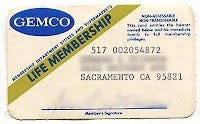Predictions Are Hard, especially about the Future
With nearly half a century in enterprise IT, I have had plenty of time to see how technology predictions over the years have been fulfilled—or not fulfilled. This was brought home to me recently while reviewing an old project document.
But first, some context. As noted in my previous post, I felt forced by a business downturn in 1983 to resign from Smith Tool and take an IT manager position at Gemco, a now defunct membership department store, then owned by Lucky Stores. This returned me to my retail roots.
A Prescient Prediction
Although I only stayed at Gemco a few months, I was put in charge of a strategic systems project: To define the requirements for a new merchandising system. We started by interviewing the senior leaders of the firm and worked our way up the organization until we reached the final interview with the CEO, Peter Harris [1].
The interview summary, dated October 18, 1983, is quite interesting, especially in one paragraph where Harris said:
We need to recognize the changes that will come in the next decade due to the spread of advanced telecommunications. It is likely that 50% to 70% of basic hardgoods and commodities will be purchased from home, eliminating the need for store visits. However, apparel and other fashion merchandise will continue to be purchased in store environments, because of the psychological need to “go shopping.”
Today, I do not recall anyone in the retail industry in the early 1980s predicting the dawn of B2C e-commerce. And apparently, even 10 years later, I was still a skeptic. In the margin of that final report, there appears a note, in my own handwriting.
How wrong he turned out to be! –FS, 3/15/93 (10 years later!)
But little did I know, 1993 was the year that the U.S Congress passed a law to commercialize the Internet, and it was also the year that Tim Berners-Lee invented the World Wide Web. And, one year later, Jeff Bezos founded Amazon. But it took another two decades before a worldwide pandemic pushed B2C e-commerce for certain categories of goods to the levels that Peter Harris predicted nearly 40 years earlier.
So, no, Harris’s prediction was not wrong. He was just off by about 30 years.
Lesson Learned: Keep an Open Mind
As Yogi Berra once said, predictions are hard, especially about the future. Like many others, I tend to be a skeptic, always looking for the negative side of an idea, or what could go wrong. In fact, a few years ago, I wrote a blog post mocking fellow analysts who make year-end predictions. I don't like to make predictions myself and I tend to be skeptical of those who do make them. I have to make a conscious effort to fight this tendency.
So what predictions are out there that might seem far-fetched today but could eventually come into realization?
The Metaverse. There are many breathless predictions these days about “the metaverse,” a virtual world where people and organizations can live and interact in a persistent and immersive 3D environment, where they can own virtual property, trade virtual goods, and be educated or entertained. Some argue that the metaverse already exists with various gaming platforms. Others think it is being overhyped by social media companies, such as Facebook (now branded as Meta) that are otherwise out of ideas about how to keep people engaged on their platforms in order to target them for advertisements.
Non-Fungible Tokens. NFTs have been a hot market over the past year, with sales of digital art, secured by NFTs on a blockchain, trading for thousands or millions of dollars. The fact that any piece of digital art can be saved with a mouse right-click makes it difficult to understand what exactly an NFT denotes in terms of ownership. The recent and rapid decline in the value of various NFTs confirms to skeptics that they are nothing more than the 21st century equivalent of Tulipmania.
Cryptocurrencies. Digital currencies using cryptography, such as Bitcoin, are built using blockchain technology. In contrast to fiat money, such as the US Dollar, they are not backed by a central government but are decentralized, permissionless, and virtually impossible to corrupt. Advocates predict they will replace fiat money, or at least exist alongside it, providing a hedge against inflation and very low transaction costs compared to traditional currency exchanges. At this writing, there is a collapse in cryptocurrency markets, confirming the view of crypto-critics that the whole thing is one big bubble.
It is easy to be a critic, or as Ed Debono taught, to put on the black hat. It is not so easy to see the problems with an idea while at the same time seeing where there could be value. It is even more difficult to predict when exactly that value might be realized.
Sometimes, predictions are not wrong. They just take longer than we think to be realized.
Footnote
[1] Peter Harris is an interesting person, starting as a stocking clerk at Gemco and eventually working his way up to President from 1980 to 1984, when the firm achieved $2.2 billion in revenues. Later, he and his partner acquired FAO Shwarz, where he took over as CEO until 1992. Later, he became the President and CEO of the San Francisco 49ers (2000-2004), and held several other leadership positions after that. Today, he is retired and serves on several boards, including Palo Alto Medical Foundation. He is still on LinkedIn.
Update, May 22, 2022
One of the joys in writing this series of career posts is reconnecting with people I worked with decades ago. So, I sent a message to Peter Harris on LinkedIn.
Peter, I'm sure you don't remember me, but I interviewed you in 1983 at Gemco. I just wrote a blog post about your prediction about E-commerce. [Link to this post.] Let me know any feedback. --Frank
This morning he wrote back:
Frank, I am absolutely blown away to hear from you and read of your perspective, highlighted of course by your absolutely amazing record keeping mention of something I said many years ago. While I think 30 years early doesn't count as anything beyond being impracticably thoughtful, I was honored and hugely appreciative to be recognized. Your article is fascinating and I am now following you so that I might observe and learn from your thinking and musings on other topics. That you have tracked me down on LinkedIn and shared it means a lot. The appropriate comments are "way cool," "awesome" or maybe even "wowza." Thank you so very much. I'd be interested to hear a bit more than is visible on LinkedIn about what you are doing now if you have time to share. --Peter
[Posted with Peter's permission.]
Update, Aug. 8, 2022
The same year, 1983, Mark Dertouzos made this incredible prediction of the World Wide Web. Click to watch.
Update, June 3, 2024
Here is another remarkable prediction from 1964, along the same lines, this one from Arthur C. Clarke, Here, he predicts the rise of the internet, remote working, and even telemedicine. In fact, we have not yet fully achieved his vision.
Photo Credits:
Peter Harris Interview Notes: Frank Scavo







